Introduction
Thank you for affording me the privilege of delivering the keynote address this evening.
It is a pleasure to address a gathering of the mining sector, an industry that has always been a special interest for me. It started when I was 20 and Lang Hancock invited me up to Wittenoom to have a look at some of the magnificent iron ore mines of the Pilbara. It continued when I was a legal adviser to Robe River during its dramatically successful reform of restrictive work practices in 1986.
Mining Industry
Mining contributes around 5 per cent of Australia's GDP.
Figure 1: Sectoral contribution to GDP, 2000-01
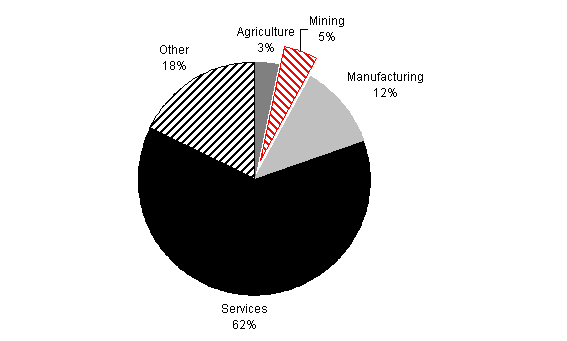
In 2000-01, mineral exports were valued at $42 billion, or around 35 per cent of total export earnings. The sector's export performance is critical to our balance of payments position and the strength of the Australian economy.
Figure 2: Minerals contribution to total Australian exports 2000/01
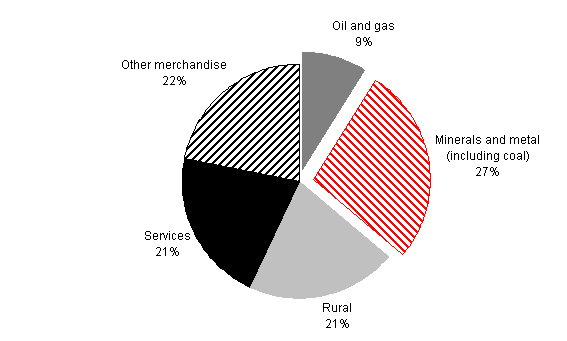
Australia is the world's largest exporter of coal, accounting for about one-third of the world trade. Australia is also the world's largest exporter of iron ore, lead, diamonds, rutile, zinc and zirconium, and the second largest exporter of gold and uranium. Our exports of gold and uranium each account for one fifth of the world trade. Australia is also the third largest exporter of aluminium.
The mining industry is one of Australia's most capital-intensive industries, with about $1.4 million of capital stock per employee. This is about five times the average across industries. The quality of the capital stock is just as important as the quantity. Here again, the Australian industry is amongst the best in the world. Indeed, over 60 per cent of the world's mining operations utilise technology developed by Australian companies. As a consequence mining technology service companies are a growing and diverse sector of the Australian economy, with the value of exports estimated at $1.9 billion for 2001.
Maintaining an effective capital stock requires substantial ongoing investment. Around 12 per cent of Australia's new business investment expenditure is attributable to the mining industry. Prior to the Asian crisis of 1997, Australian business investment was lifted by a surge in mining investment, which grew by around 81 per cent in four years to 1997-98. The onset of the Asian crisis saw mining investment fall. However our Budget forecasts indicate that mining investment is set to pick up markedly in the period ahead, and that work has already commenced, or is about to commence, on a number of large projects, particularly in the gas, coal and metals sectors.
The 25th Minerals Industry Survey also found that profitability for the industry improved strongly in 2000-01. A competitive dollar, higher commodity prices and efficiency gains in the industry saw net profit return on average shareholders' funds come in at 13.9 per cent compared with 4 per cent in 1999-00, 3.7 per cent in 1998-99 and 1.8 per cent in 1997-98. Last year's profitability also compares favourably with the ten year average of 6.9 per cent and the average for the 25 years of the survey of 10.1 per cent.
After the investment lull arising from the Asian financial crisis, the coming together of much stronger profitability and higher commodity prices is driving an investment recovery, as indicated in the latest ABS capital expenditure data. Firms have indicated that growth in mining investment of over 40 per cent is in prospect for 2002-03.
Figure 3: Mining industry profit and nominal investment
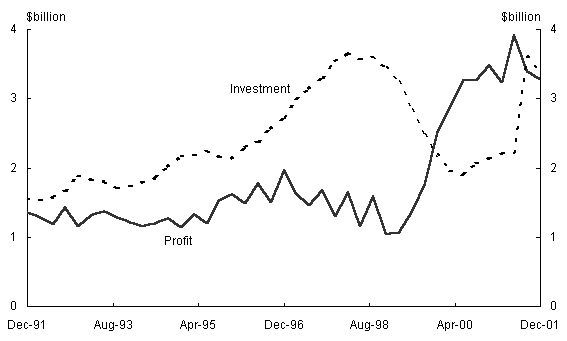
The mining industry plays a key role in the development of regional Australia, providing community facilities, transport infrastructure such as roads, ports, airports and railways, communications facilities, and in some cases, entire towns. The minerals industry is also a key provider of employment and training to the indigenous communities.
Of course, without adequate ongoing exploration the minerals industry would soon lose its position of leadership. For this reason we must constantly assess the impact of national title and environmental controls on mineral exploration. Still, Australia had the world's second highest level of expenditure on non-ferrous mineral exploration in 1999, 2000 and 2001. This does not mean we should not have the highest.
The outlook for the sector is bright. The competitive Australian dollar, together with higher world prices and an expected global recovery has pushed profitability in the mining industry to well beyond previous levels, resulting in turn, in further increases in investment.
National Accounts
Today's National Accounts show that the Australian economy continued to grow solidly in the March quarter of 2002, adding further to our economic security and stability. Australia's GDP increased by 0.9 per cent in the March quarter and by 4.2 per cent through the year to March 2002, in line with the growth recorded during 2001. This growth rate markedly exceeds that of any of the world's major developed economies.
The March quarter National Accounts also confirm that inflation remains moderate.
Household consumption increased by 1.4 per cent in the March quarter of 2002 and was 4.0 per cent higher than a year ago, making a major contribution to overall economic growth.
Net exports contributed 0.3 of a percentage point to GDP growth in the March quarter. Exports increased by 4.0 per cent, which is the strongest quarterly growth since the September quarter 2000. The recovery in exports in the March quarter is consistent with early signs of an economic recovery among some of Australia's trading partners. Imports were up by 2.2 per cent in the March quarter as demand for imports was supported by growth in domestic spending. Australia's terms of trade rose by 1.8 per cent in the March quarter, continuing the upward trend evident since 1998, despite the recent weakness in the world economy.
The National Accounts measure of profits in the private non-financial corporate sector recorded solid growth of 4.6 per cent in the March quarter. Profits were up by 8.8 per cent through the year to March. Gross mixed income was up by an exceptional 11.7 per cent through the year to March, boosted by profitability in the farm sector.
The Australian economy has performed very well during a period of global economic uncertainty and weakness. Going forward, improved prospects for a world recovery and rising confidence levels will provide continued momentum for the Australian economy. Exports are likely to strengthen over this period as Australia's major trading partners recover, and business investment will become a major driver of economic growth in 2002-03. This positive outlook will enhance Australia's ongoing economic prosperity and security.
Government Leadership
This audience will understand readily that a strong and stable economy is of direct benefit to all sectors of the economy, including the mining industry.
Australia's strong economic performance during the recent period of weak global growth has been assisted by sound macroeconomic policy and the payoff from sustained microeconomic reform.
A direct benefit of our recent economic performance is the low cost of capital for Australian firms. Current interest rates on business overdrafts of around 8 per cent are around levels not seen for at least 20 years, furthermore the interest rate on the average business loan is a very low 7 per cent. Solid demand for Australian corporate bonds is also making it easier for companies to obtain finance at very competitive rates.
Record profits currently being enjoyed by the mining sector mean that internal funds are now more plentiful than a few years ago. The relatively strong performance of the Australian stock market suggests that conditions for raising equity capital remain very favourable. In fact, the mining industry accounted for almost one in three initial public offerings in the March quarter, and most of the companies expected to list on the ASX in coming months are mining ventures.
The success of recent capital raisings such as Amcor (A$2.9 billion), the Macquarie Infrastructure group (A$1.7 billion) and the Westfield America Trust, where over $2 billion of quality demand was identified in under 18 hours, and institutional placement was scaled up to $1.15 billion after 4 hours, provides some indication of the ability of the Australian capital markets to support large capital raisings.
Tax Reform
This great show of investor confidence, has, I believe, been underpinned by the business tax initiatives and indirect tax reforms undertaken by the Government in recent years, to give Australia a modern, internationally competitive taxation system which has therefore benefited the mining industry.
The tax reforms have seen:
- The removal of embedded taxes on exports with the abolition of WST and the introduction of GST which makes exports tax free
- A full rebate to replace the partial rebate for excise on diesel used for mining operations
- A full rebate for excise on diesel used in rail transport
- Cost reductions for on-road diesel of 18.5 cents per litre through the Diesel and Alternative Fuels Grants Scheme
- Reduction in the company tax rate from 36 per cent to 30 per cent
- Capped effective lives for gas transmission and distribution assets (20 years), offshore oil and gas platforms (20 years), oil and gas production assets (15 years) and assets used to manufacture condensate, crude oil, domestic gas, liquid natural gas and liquid petroleum gas (15 years)
- Capital gains tax relief on demergers
- Consolidation
- Scrip for scrip rollover relief
- Blackhole deductions where the mining industry benefits from being able to write off expenditure such as capital raising costs on a straight-line basis over five years. Other costs such as community infrastructure upgrade costs may be written off over the lifetime of the mining project.
Globalisation
I now want to turn to some of the drivers underlying your theme of leadership embracing change. A process which has received greater scrutiny in recent years is globalisation - that is, the advances in communication, information technology and transport which have expanded international markets in the trade of goods and services, and increased competition for investment. These developments are creating global markets and reducing the effectiveness of national boundaries, and are, in my view, quite likely to accelerate.
As I have previously argued, globalisation is not a value, it is a process. Globalisation describes what is happening. Our choice is not whether to stop the processes, but how to adapt and manage them for the benefit of our citizens.
Of all the countries in the world where this should be well understood, it is Australia. The founding of the colonies in Australia was an example of globalisation. At the end of the 18th Century as its economy strengthened and its technological capacity developed, Britain was able to establish and maintain a settlement 12,000 nautical miles from its global centre in London. It couldn't do this in the 16th Century where its capacity to maintain colonies extended only 3,000 nautical miles to North America. That settlement was Australia. And two of Australia's great industries - mining and agriculture - grew on the basis of exports; global sales.
The mining industry did not seek tariffs or domestic price support schemes to protect it against global competition. Competition forced it to become efficient, in many respects the most efficient in the world.
Two years ago, when the NASDAQ was still rising and the dot.com bubble was in full swing it was common for press commentators to lament that Australia was an `old' economy with industries like mining rather than a `new' economy with clean bright ICT industries.
When you pointed out (as I did) that Australia was a great user of ICT which made it very much a `new' economy the critics would dismiss this as second rate. What we needed (they said) was semi conductor and ICT manufacturing to be a real `new' economy.
Shortly the NASDAQ was to fall, the dot.com bubble burst and countries reliant on the manufacture and export of ICT were hit hard by recession. Our country avoided recession and grew faster than any comparable developed economy in 2001-2002.
Have a guess which industries are now back in favour?
None of this is to underestimate the importance of productivity and the use of ICT to improve all business operations. But it is the productivity improvements to other industries - including mining - that counts. In fact one of the industries in Australia that has the highest and most sophisticated utilization of ICT is the mining industry.
Why? Because it is exposed to global competition and needs to be at the cutting edge of productivity improvements to survive.
Foreign Investment
One aspect of globalisation that has attracted attention over recent months is foreign investment.
In the past few years, I have had to make a number of decisions to balance competing interests and ensure that foreign investment is conducive to the development of the resource and processing sectors in Australia.
As you know I rejected Shell's proposed bid for Woodside Petroleum in 2001. It was, as I said at the time, a tough decision. The issue was not about whether the companies were Australian or foreign - both firms are foreign under the Foreign Acquisitions and Takeovers Act. The issue was whether I could be sufficiently certain that following the takeover, the North West Shelf would be developed in a way that would benefit Australia and lead to the maximum development and exploitation of that great natural resource. In that case I could not. I took the view that it was contrary to the national interest. The rejection was one of a handful (not counting real estate) since I have been Treasurer and the only rejection in the mining sector.
Contrast that with the case of Mitsui's acquisition of the Moura Coal mine.
Mitsui is one of the world's largest mining and natural resource conglomerates. Over the last forty years Mitsui has acquired significant Australian mineral assets including coal mines in Queensland and New South Wales, and has made a significant contribution to the development of the Moura Coal Mine since the 1960s. This acquisition received considerable media attention as Mitsui was competing with an Australian mining firm, MIM Holdings, for the right to acquire the additional 55 per cent interest.
The significance of the ultimate acquisition relates to changes that are occurring in the way coal is mined and more specifically, marketed around the world. The blending of different coals to deliver a consistent product is a key commercial strategy. Acquisition of a further interest in the Moura Mine gave Mitsui that capability. I had no doubt that the acquisition would not inhibit the development and exploitation of that great natural resource and consequently was not contrary to the national interest.
The long term
But if you will allow me, I want to come back to the theme of leadership and talk briefly about the next big task of Government leadership with the release of the first ever Intergenerational Report (IGR).
The IGR identifies changes which we know are occurring now and attempts to project the impact they may have on public finances in 40 years time. Like the mining industry, the Commonwealth has several areas where long term trends are an important consideration in our planning and long lead times are required to bring about and implement change.
Let me refer briefly to the analysis in the IGR.
Firstly, it finds that while the budget situation is manageable in the next 10-15 years, the gap between spending and revenue could grow to 5 per cent of GDP by 2042 or around $87 billion in today's dollars.
Figure 4: Fiscal pressure
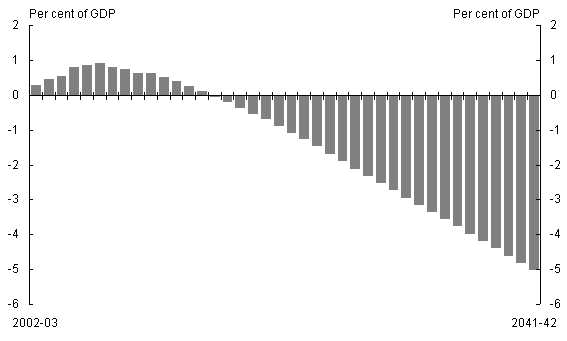
Secondly, the overall conclusion is that we as a nation are better placed to cope with future budget pressures than most comparable countries because we have been repaying Labor's debt and strengthening our financial position.
Figure 5: General government net debt levels in selected countries
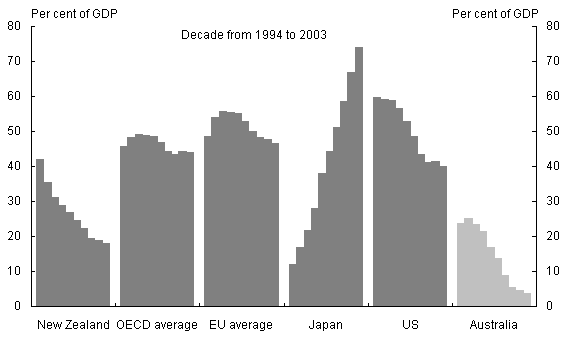
Our targeted pension scheme and superannuation arrangements also protect our financial position as the population ages.
Thirdly, health spending, and in particular the cost of the Pharmaceuticals Benefits Scheme (PBS), is the fastest growing area of spending. This is not simply a result of an ageing population. In fact nearly two thirds of the growth in health spending over the past decade has come from non-demographic factors - that is advances in technology in both treatments and medicines.
The cost of the PBS has quadrupled over the last decade.
Figure 6: Growth in the PBS
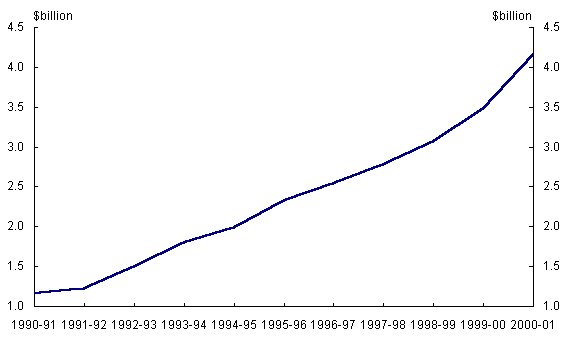
But this is nothing compared to the next decade and beyond. The IGR projects that PBS spending could grow more than fivefold from a current 0.6 per cent of GDP to 3.4 per cent in 2041-42. This increase, of course, applies to a growing GDP so in nominal dollar terms the projections take PBS spending from about $4.3 billion in 2001-02 to about $158 billion in 2041-42.
Figure 7: Further growth in the PBS
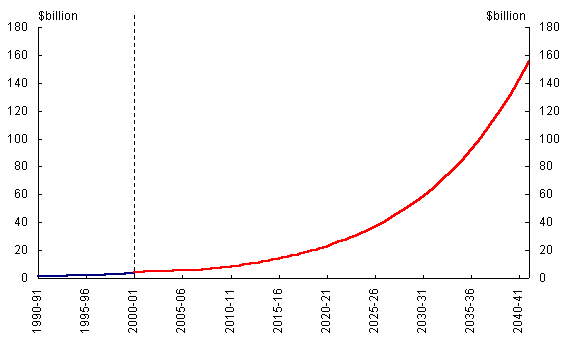
The point I make here is that if small changes are not made now, more drastic changes will have to be made in the future to put the PBS on a sustainable footing. By making the PBS more sustainable, the Government can continue to provide Australians with affordable access to new, highly effective, but expensive medicines.
For example,
- Humulin NPH, a drug widely used in the treatment of insulin dependent diabetes costs $229.13 per prescription; and
- Avonex, a drug widely used for the treatment of multiple sclerosis costs $1,090.81 per prescription. A patient on this drug would normally take 13 prescriptions per year.
Under our proposals to limit the rate of growth in PBS costs - not cut the costs - we will make these drugs available to pensioners and concession card holders for $4.60 and to other Australians for $28.60 per prescription. That is, for Avonex, the Government subsidy will be $1086.21 for pensioners and concession card holders and $1062.21 for other Australians.
For concession cardholders, prescriptions are free after 52 prescriptions are filled in a year. For non-concession cardholders, prescriptions will only cost $4.60 after about 31 prescriptions in a year.
To ensure that necessary medicines such as Humulin NPH and Avonex can continue to be listed on the PBS, we must act now to adjust the scheme and get it on a more sustainable footing.
The Labor Party likes to pretend that by opposing the Government's changes it will help the poor. Nothing could be further from the truth. The sick and poor will suffer most if the taxpayer cost of the PBS escalates at the current rate. The system will become unsustainable. In order to meet costs at first, Governments will refuse to admit new treatments to the scheme, later others will be delisted but eventually the scheme will collapse. Only those able to pay market price will have access to pharmaceuticals in such a scenario.
We can make small adjustments now. The longer we leave it the more drastic the adjustments will become in the future. There are two alternatives - small moderate changes now, large drastic ones later. Do nothing is not an option.
Conclusion
In conclusion, let me reiterate the Government's continuing support for your industry, and express my thanks for its contribution to Australia's economic performance over many years.
It is clear that the challenges posed by greater globalisation, the demand for environmental sustainability and the need for international competitiveness are not going to go away. If anything, they are going to intensify.
Management of these issues will require leadership to pre-empt and embrace changing circumstances, and to look over the short-term horizon to plan for longer term eventualities.
Just as it is incumbent upon governments to lead and to embrace change and to plan for the future, so too the mining sector must put leadership into practice for the benefit of all Australians. I applaud you for recognising this in the theme for your conference this year.
